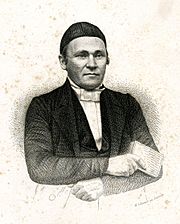Johann Ludwig Krapf facts for kids
Quick facts for kids
Johann Ludwig Krapf
|
|
|---|---|
 |
|
| Born | 11 January 1810 |
| Died | 26 November 1881 Korntal, Germany
|
| Occupation | Christian Missionary |
Johann Ludwig Krapf (born January 11, 1810 – died November 26, 1881) was a German missionary, explorer, and linguist. He traveled a lot in East Africa. Krapf was very important in exploring this region, especially with his friend Johannes Rebmann. They were the first Europeans to see the tall, snow-capped mountains of Mount Kenya and Mount Kilimanjaro. Krapf also helped explore the coastline of East Africa.
Contents
Early Life and Learning
Johann Ludwig Krapf was born into a farming family in southwest Germany. From a young age, he showed a great talent for languages. He first learned Latin, Greek, French, and Italian. He would learn many more languages throughout his life.
At 17, he joined a special school called the Basel Mission Seminary. This school trained people to become missionaries. However, he later left because he wasn't sure if being a missionary was his path. He then studied theology at the University of Tübingen and finished in 1834. While working as a village pastor, he met another missionary who encouraged him to follow his dream of missionary work.
Adventures in Ethiopia
In 1836, Krapf was invited by the Anglican Church Missionary Society (CMS) to work in Ethiopia. He worked there from 1837 to 1842. To prepare, he learned ancient Ge'ez and the Amharic language, which was spoken in the highlands.
He traveled to Shewa and met its ruler, Sahle Selassie. Krapf was very interested in the Oromo people of southern Ethiopia. At that time, many Oromo people followed traditional religions. Krapf learned their language and began translating parts of the New Testament into it.
In 1842, Krapf earned a doctorate from the University of Tübingen for his studies of Ethiopian languages. However, all Western missionaries were soon asked to leave Ethiopia, which ended his work there. With his colleague, Carl Wilhelm Isenberg, he published a book about his time in Ethiopia called Journals of Isenberg and Krapf in 1843.
Exploring Kenya
After leaving Ethiopia, Krapf spent some time in Alexandria, Egypt, where he got married. From there, he sailed to East Africa. He hoped to reach the Oromo people from the Kenyan coast. Most of the East African coast was then part of the Zanzibar sultanate. The Sultan, Sayyid Said, gave Krapf permission to start a missionary station in the city of Mombasa.
Krapf immediately started learning the languages of the local Mijikenda people. He also learned Swahili, which was a common language for communication across East Africa. Sadly, soon after arriving in Mombasa, his wife and young daughter became sick with malaria and died.
Krapf then moved to higher ground in Rabai on the coastal hills. He started his mission station there, which he called New Rabai(Rabai Mpya). Here, he created the first dictionary and grammar book for the Swahili language. He also studied other African languages, making dictionaries and translating parts of the Bible. He worked with a Muslim judge named Ali bin Modehin to translate the book of Genesis.
In 1846, Johannes Rebmann, another German Lutheran missionary, joined Krapf. Krapf and Rebmann set out to explore the inner parts of East Africa. They became the first Europeans to see the amazing snow-capped mountains of Mount Kilimanjaro and Mount Kenya. When they sent reports about these mountains back to Europe, many experts didn't believe them and even made fun of their claims.
Krapf's health got worse, so he had to return to Germany in 1853. He brought with him several old Swahili writings, including copies of the Book of the Battle of Tambuka, which is the oldest known Swahili manuscript. In Korntal, Germany, he continued his language studies and advised Christian missions.
Krapf's Lasting Impact
Johann Ludwig Krapf left a big mark on history:
- The Anglican Church of Kenya sees him as its founder.
- Language experts still use his work today. He studied many different languages, including Ge'ez, Amharic, Oromo, Swahili, Kamba, Mijikenda, and Maasai language.
- His house at New Rabai is now part of the Rabai Museum, one of the National Museums of Kenya. The German Embassy building in Nairobi is named "Ludwig-Krapf-House" in his honor.
- In his hometown of Tübingen-Derendingen, there is an elementary school named after him.
Images for kids
See also
 In Spanish: Johann Ludwig Krapf para niños
In Spanish: Johann Ludwig Krapf para niños


